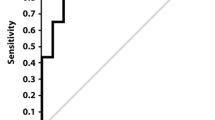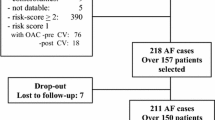Abstract
Background
Flecainide is used as a pill-in-the-pocket treatment for pharmacological cardioversion in patients without structural heart disease and atrial fibrillation (AF). In patients with structural heart disease and elevated cardiovascular risk, flecainide is believed to be harmful. Therefore, data about safety and effectiveness of single-dose flecainide for cardioversion in patients at elevated cardiovascular risk are lacking.
Objectives
One-hundred and six consecutive patients with recent onset AF and known structural heart disease and/or elevated PROCAM-score did receive oral flecainide 300 mg for cardioversion.
Methods
The effectiveness, safety and influencing factors of flecainide for cardioversion in high-risk patients were prospectively assessed.
Results
In 43 of 106 patients (40.6%), sinus rhythm could be restored within 192.4 ± 10.7 min by flecainide. The PROCAM-score was 41.5 ± 0.56 in patients with successful cardioversion compared to 45.7 ± 0.74 in patients without successful cardioversion (P < 0.001). ACE-inhibitor co-medication was associated with a significantly lower rate of conversion by flecainide (HR 2.3, 95% CI, 1.12–4.26, P < 0.01). In 58 of 63 patients in whom cardioversion by flecainide was not effective, electrical cardioversion was performed which was successful in 47 patients. Life-threatening arrhythmias did not occur in any patient. The most common side effect was sinus-bradycardia and transient sinus arrest (2–4 s) immediately after conversion.
Conclusions
When monitored properly, flecainide is safe and useful for cardioversion in patients at elevated cardiovascular risk.



Similar content being viewed by others
References
Wyse DG, Waldo AL, DiMarco JP, Domanski MJ, Rosenberg Y, Schron EB, Kellen JC, Greene HL, Mickel MC, Dalquist JE, Corley SD (2002) A comparison of rate control and rhythm control in patients with atrial fibrillation. N Engl J Med 347(23):1825–1833
Donovan KD, Power BM, Hockings BE, Dobb GJ, Lee KY (1995) Intravenous flecainide versus amiodarone for recent-onset atrial fibrillation. Am J Cardiol 75(10):693–697
Donovan KD, Dobb GJ, Coombs LJ, Lee KY, Weekes JN, Murdock CJ, Clarke GM (1992) Efficacy of flecainide for the reversion of acute onset atrial fibrillation. Am J Cardiol 70(5):50A–54A (discussion 54A-55A)
Martinez-Marcos FJ, Garcia-Garmendia JL, Ortega-Carpio A, Fernandez-Gomez JM, Santos JM, Camacho C (2000) Comparison of intravenous flecainide, propafenone. and amiodarone for conversion of acute atrial fibrillation to sinus rhythm. Am J Cardiol 86(9):950–953
Alboni P, Botto GL, Baldi N, Luzi M, Russo V, Gianfranchi L, Marchi P, Calzolari M, Solano A, Baroffio R, Gaggioli G (2004) Outpatient treatment of recent-onset atrial fibrillation with the “pill-in-the-pocket” approach. N Engl J Med 351(23):2384–2391
Akiyama T, Pawitan Y, Greenberg H, Kuo CS, Reynolds-Haertle RA (1991) Increased risk of death and cardiac arrest from encainide and flecainide in patients after non-Q-wave acute myocardial infarction in the Cardiac Arrhythmia Suppression Trial. CAST Investig Am J Cardiol 68(17):1551–1555
Echt DS, Liebson PR, Mitchell LB, Peters RW, Obias-Manno D, Barker AH, Arensberg D, Baker A, Friedman L, Greene HL et al (1991) Mortality and morbidity in patients receiving encainide, flecainide, or placebo. The Cardiac Arrhythmia Suppression Trial. N Engl J Med 324(12):781–788
Cardiac Arrhythmia Suppression Trial II Investigators (1992) Effect of the antiarrhythmic agent moricizine on survival after myocardial infarction. N Engl J Med 327(4):227–233
Teo KK, Yusuf S, Furberg CD (1993) Effects of prophylactic antiarrhythmic drug therapy in acute myocardial infarction. An overview of results from randomized controlled trials. JAMA 270(13):1589–1595
Assmann G, Cullen P, Schulte H (2002) Simple scoring scheme for calculating the risk of acute coronary events based on the 10-year follow-up of the prospective cardiovascular Munster (PROCAM) study. Circulation 105(3):310–315
Kirchhof P, Eckardt L, Loh P, Weber K, Fischer RJ, Seidl KH, Bocker D, Breithardt G, Haverkamp W, Borggrefe M (2002) Anterior-posterior versus anterior-lateral electrode positions for external cardioversion of atrial fibrillation: a randomised trial. Lancet 360(9342):1275–1279
Van Gelder IC, Hagens VE, Bosker HA, Kingma JH, Kamp O, Kingma T, Said SA, Darmanata JI, Timmermans AJ, Tijssen JG, Crijns HJ (2002) A comparison of rate control and rhythm control in patients with recurrent persistent atrial fibrillation. N Engl J Med 347(23):1834–1840
Hohnloser SH, Kuck KH, Lilienthal J (2000) Rhythm or rate control in atrial fibrillation–Pharmacological Intervention in Atrial Fibrillation (PIAF): a randomised trial. Lancet 356(9244):1789–1794
Carlsson J, Miketic S, Windeler J, Cuneo A, Haun S, Micus S, Walter S, Tebbe U (2003) Randomized trial of rate-control versus rhythm-control in persistent atrial fibrillation: the Strategies of Treatment of Atrial Fibrillation (STAF) study. J Am Coll Cardiol 41(10):1690–1696
Opolski G, Torbicki A, Kosior DA, Szulc M, Wozakowska-Kaplon B, Kolodziej P, Achremczyk P (2004) Rate control vs rhythm control in patients with nonvalvular persistent atrial fibrillation: the results of the Polish How to Treat Chronic Atrial Fibrillation (HOT CAFE) Study. Chest 126(2):476–486
Becker T, Kleemann T, Strauss M, Doenges K, Schneider S, Senges J, Seidl K (2008) Long-term prognosis after cardioversion of the first episode of symptomatic atrial fibrillation: a condition believed to be benign revised. Clin Res Cardiol 97(2):74–82
Kleemann T, Becker T, Donges K, Vater M, Gut B, Schneider S, Senges J, Seidl K (2007) The prognostic impact of successful cardioversion of atrial fibrillation in patients with organic heart disease. Clin Res Cardiol 96(2):103–108
Capucci A, Boriani G, Botto GL, Lenzi T, Rubino I, Falcone C, Trisolino G, Della Casa S, Binetti N, Cavazza M et al (1994) Conversion of recent-onset atrial fibrillation by a single oral loading dose of propafenone or flecainide. Am J Cardiol 74(5):503–505
Crijns HJ, van Gelder IC, Lie KI (1988) Supraventricular tachycardia mimicking ventricular tachycardia during flecainide treatment. Am J Cardiol 62(17):1303–1306
Alp NJ, Bell JA, Shahi M (2000) Randomised double blind trial of oral versus intravenous flecainide for the cardioversion of acute atrial fibrillation. Heart 84(1):37–40
Iravanian S, Dudley SC Jr (2008) The renin-angiotensin-aldosterone system (RAAS) and cardiac arrhythmias. Heart Rhythm 5(6 Suppl):S12–S17
Makkar KM, Sanoski CA, Spinler SA (2009) Role of angiotensin-converting enzyme inhibitors, angiotensin II receptor blockers and aldosterone antagonists in the prevention of atrial and ventricular arrhythmias. Pharmacotherapy 29(1):31–48
Ehrlich JR, Hohnloser SH, Nattel S (2006) Role of angiotensin system and effects of its inhibition in atrial fibrillation: clinical and experimental evidence. Eur Heart J 27(5):512–518
Belluzzi F, Sernesi L, Preti P, Salinaro F, Fonte ML, Perlini S (2009) Prevention of recurrent lone atrial fibrillation by the angiotensin-II converting enzyme inhibitor ramipril in normotensive patients. J Am Coll Cardiol 53(1):24–29
Murray KT, Rottman JN, Arbogast PG, Shemanski L, Primm RK, Campbell WB, Solomon AJ, Olgin JE, Wilson MJ, Dimarco JP, Beckman KJ, Dennish G, Naccarelli GV, Ray WA (2004) Inhibition of angiotensin II signaling and recurrence of atrial fibrillation in AFFIRM. Heart Rhythm 1(6):669–675
Climent VE, Marin F, Mainar L, Gomez-Aldaravi R, Martinez JG, Chorro FJ, Roman P, Sogorb F (2004) Effects of pretreatment with intravenous flecainide on efficacy of external cardioversion of persistent atrial fibrillation. Pacing Clin Electrophysiol 27(3):368–372
Hohnloser SH, Crijns HJ, van Eickels M, Gaudin C, Page RL, Torp-Pedersen C, Connolly SJ (2009) Effect of dronedarone on cardiovascular events in atrial fibrillation. N Engl J Med 360(7):668–678
Roy D, Pratt CM, Torp-Pedersen C, Wyse DG, Toft E, Juul-Moller S, Nielsen T, Rasmussen SL, Stiell IG, Coutu B, Ip JH, Pritchett EL, Camm AJ (2008) Vernakalant hydrochloride for rapid conversion of atrial fibrillation: a phase 3, randomized, placebo-controlled trial. Circulation 117(12):1518–1525
Conflict of interest statement
None.
Author information
Authors and Affiliations
Corresponding author
Rights and permissions
About this article
Cite this article
Er, F., Aslan, O., Caglayan, E. et al. Flecainide for cardioversion in patients at elevated cardiovascular risk and persistent atrial fibrillation: a prospective observational study. Clin Res Cardiol 99, 369–373 (2010). https://doi.org/10.1007/s00392-010-0129-7
Received:
Accepted:
Published:
Issue Date:
DOI: https://doi.org/10.1007/s00392-010-0129-7




